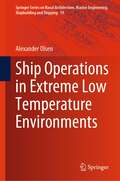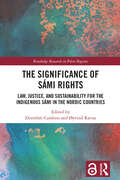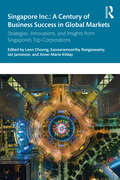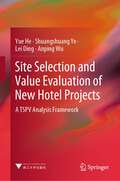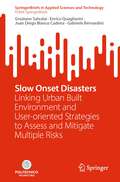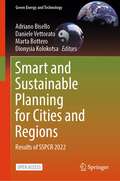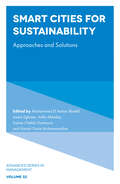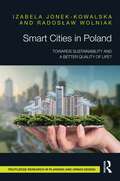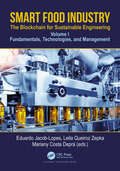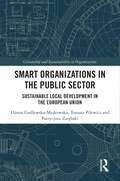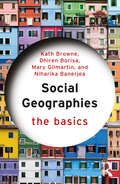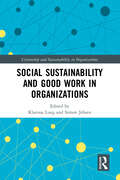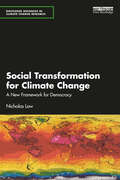- Table View
- List View
Ship Operations in Extreme Low Temperature Environments (Springer Series on Naval Architecture, Marine Engineering, Shipbuilding and Shipping #19)
by Alexander OlsenThis book recognizes the fact that the vessels' intended operational profile may vary as some vessels are intended to operate with the assistance of an ice breaker and others are intended to operate independently. The guidance provided in this book is proposed to apply to all vessels that are designed, equipped and intended to operate in low-temperature environments. Special attention is given to those vessels operating for extended periods in the Arctic regions, as this presents specific and unique challenges for vessels and crew members. The application of the guidance in this book is optional. When a vessel is designed, equipped, built and surveyed in accordance with the relevant class rules, and when found satisfactory during class notation survey, a classification notation may be granted which demonstrates the vessel's compliance with the appropriate class requirements for vessels operating in low-temperature environments. Those vessels that are designed to meet the requirements of an ice class are typically required to meet specific class rules around “strengthening for navigation in ice” or other equivalent and recognized ice class rules. Accordingly, this book also provides guidance related to the requirements which address the duration of emergency electrical power. This extended emergency power duration is expressed in hours and may be appended to the base optional class notations. To provide as much context as possible, this book refers to the most relevant international regulations and standards that are considered to be applicable. It is recommended that readers of this book refer to the most recent text of those regulations and standards when seeking to apply the guidance set out herein, as it is the intent of the book to remain consistent with the pertinent international regulations and standards developed by the global maritime industry.
A Short Introduction to Mathematical Concepts in Physics
by Jim NapolitanoMathematics is the language of physics and yet, mathematics is an enormous subject. This textbook provides an accessible and concise introduction to mathematical physics for undergraduate students taking a one semester course. It assumes the reader has studied a year of introductory physics and three semesters of basic calculus, including some vector calculus, but no formal training in differential equations or matrix algebra. It equips readers with the skills and foundational knowledge they need for courses that follow in classical mechanics, electromagnetism, quantum mechanics, and thermal physics. This book exposes students early on to the kinds of mathematical manipulations they will need in upper-level courses in physics. It can also serve as a useful reference for their further studies. Key features: Accompanied by homework problems and a solutions manual for instructors, available upon qualifying course adoption Bridges the gap between calculus and physics, explaining fundamental mathematics (differentiation, integration, infinite series) in physical terms Explores quick extensions into mathematics useful in physics, not typically taught in math courses, including the Gamma Function, hyperbolic functions, Gaussian integrals, Legendre polynomials, functions of a complex variable, and probability distribution functions
A Short Introduction to Mathematical Concepts in Physics
by Jim NapolitanoMathematics is the language of physics and yet, mathematics is an enormous subject. This textbook provides an accessible and concise introduction to mathematical physics for undergraduate students taking a one semester course. It assumes the reader has studied a year of introductory physics and three semesters of basic calculus, including some vector calculus, but no formal training in differential equations or matrix algebra. It equips readers with the skills and foundational knowledge they need for courses that follow in classical mechanics, electromagnetism, quantum mechanics, and thermal physics. This book exposes students early on to the kinds of mathematical manipulations they will need in upper-level courses in physics. It can also serve as a useful reference for their further studies. Key features: Accompanied by homework problems and a solutions manual for instructors, available upon qualifying course adoption Bridges the gap between calculus and physics, explaining fundamental mathematics (differentiation, integration, infinite series) in physical terms Explores quick extensions into mathematics useful in physics, not typically taught in math courses, including the Gamma Function, hyperbolic functions, Gaussian integrals, Legendre polynomials, functions of a complex variable, and probability distribution functions
The Significance of Sámi Rights: Law, Justice, and Sustainability for the Indigenous Sámi in the Nordic Countries (Routledge Research in Polar Regions)
by Dorothée Cambou Øyvind RavnaThis book examines the significance of the rights of the Sámi people and analyses the issues raised by the recognition and implementation of these rights in the Nordic countries. Written together by Sámi and non-Sámi experts, the book adopts a human rights approach to examine the adequacy of law and policies that seek to protect the culture and livelihood of Sámi communities in their traditional lands and territories. The book discusses contemporary legal and jurisprudential developments in the field of Sámi rights. It examines the processes and challenges in the recognition and implementation of these rights, particularly in relation to the governance of their traditional land and resources. The book will be of particular interest to legal scholars, political scientists, experts in the field of Indigenous peoples’ rights, governmental authorities, and members of Indigenous communities.
The Significance of Sámi Rights: Law, Justice, and Sustainability for the Indigenous Sámi in the Nordic Countries (Routledge Research in Polar Regions)
This book examines the significance of the rights of the Sámi people and analyses the issues raised by the recognition and implementation of these rights in the Nordic countries. Written together by Sámi and non-Sámi experts, the book adopts a human rights approach to examine the adequacy of law and policies that seek to protect the culture and livelihood of Sámi communities in their traditional lands and territories. The book discusses contemporary legal and jurisprudential developments in the field of Sámi rights. It examines the processes and challenges in the recognition and implementation of these rights, particularly in relation to the governance of their traditional land and resources. The book will be of particular interest to legal scholars, political scientists, experts in the field of Indigenous peoples’ rights, governmental authorities, and members of Indigenous communities.
Simulation on Hydration of Tricalcium Silicate in Cement Clinker
by Dejian Shen Xin WangThis book is written based on authors' research on cement hydration during the past decade. It establishes simulation model to evaluate the influence of crystal defects on the dissolution of tricalcium silicate and morphology change of particles and explores the hydration kinetics and microstructure development of tricalcium silicate under the mixed control of dissolution, diffusion, as well as boundary nucleation and growth. It also provides a theoretical basis for regulating the microstructure and performance of cement-based materials. It is designed as a reference work for professionals or practitioners and as a textbook for undergraduates or postgraduates. This book provides valuable knowledge and useful methods that can be applied in the field of cement hydration.
Singapore Inc.: Strategies, Innovations, and Insights from Singapore's Top Corporations
This book features 100 local case studies examining the experiences of leading Singaporean companies across different sectors including aviation, logistics, banking, and real estate. They offer valuable insights into how companies adapted to evolving market dynamics, expanded their business portfolios, ventured into global markets, prioritised sustainability, and leveraged innovation and technology to maintain competitiveness. Through case studies, readers gain practical knowledge that can be applied to their own enterprises, a unique perspective into Singapore’s dynamic and competitive business landscape, and the successes and challenges faced by Singaporean companies. The book is divided into different sections exploring specific themes such as business strategy and transformation, diversification and expansion, sustainability, innovation and technology, financial performance, and risk management. It scrutinises how companies responded to shifting market conditions, competition, regulations, customer preferences, and global events. Additionally, it sheds light on the obstacles companies encountered in terms of sustainable practices, financial performance, risk management, talent retention, and technological advancements. By presenting cases across industries and companies in Singapore, Choong et al. highlight their triumphs, setbacks, and valuable lessons learned. This book can be rendered as a practical and essential resource for business professionals, entrepreneurs, and students interested in understanding effective business strategies.
Singapore Inc.: Strategies, Innovations, and Insights from Singapore's Top Corporations
by Leon Choong Easwaramoorthy Rangaswamy Ian Jamieson Anne-Marie KildayThis book features 100 local case studies examining the experiences of leading Singaporean companies across different sectors including aviation, logistics, banking, and real estate. They offer valuable insights into how companies adapted to evolving market dynamics, expanded their business portfolios, ventured into global markets, prioritised sustainability, and leveraged innovation and technology to maintain competitiveness. Through case studies, readers gain practical knowledge that can be applied to their own enterprises, a unique perspective into Singapore’s dynamic and competitive business landscape, and the successes and challenges faced by Singaporean companies. The book is divided into different sections exploring specific themes such as business strategy and transformation, diversification and expansion, sustainability, innovation and technology, financial performance, and risk management. It scrutinises how companies responded to shifting market conditions, competition, regulations, customer preferences, and global events. Additionally, it sheds light on the obstacles companies encountered in terms of sustainable practices, financial performance, risk management, talent retention, and technological advancements. By presenting cases across industries and companies in Singapore, Choong et al. highlight their triumphs, setbacks, and valuable lessons learned. This book can be rendered as a practical and essential resource for business professionals, entrepreneurs, and students interested in understanding effective business strategies.
Site Selection and Value Evaluation of New Hotel Projects: A TSPV Analysis Framework
by Yue He Shuangshuang Ye Lei Ding Anping WuThe book constructs a holistic analytical framework for the selection of hotel sites and the evaluation of their value, employing the TSPV (Target Analysis—Site Selection—Project Planning—Value Assessment) methodology, particularly in the context of emerging urban (new area) developments.Proceeding from a theoretical foundation in the TSPV paradigm, the book methodically dissects and examines various components such as factor analysis, market feasibility, and financial scrutiny, pertinent to the process of hotel site selection. It adopts an interdisciplinary approach, integrating these elements, while also addressing the ramifications of uncertainty analysis within the hotel industry.Readers can be navigated through the TSPV framework to engage in a scientifically grounded and logically coherent exploration of critical aspects like site selection, strategic positioning, profitability, and the overall valuation of prospective hotel ventures.
Slow Burn: The Hidden Costs of a Warming World
by Robert Jisung ParkHow the subtle but significant consequences of a hotter planet have already begun—from lower test scores to higher crime rates—and how we might tackle them todayIt&’s hard not to feel anxious about the problem of climate change, especially if we think of it as an impending planetary catastrophe. In Slow Burn, R. Jisung Park encourages us to view climate change through a different lens: one that focuses less on the possibility of mass climate extinction in a theoretical future, and more on the everyday implications of climate change here and now.Drawing on a wealth of new data and cutting-edge economics, Park shows how climate change headlines often miss some of the most important costs. When wildfires blaze, what happens to people downwind of the smoke? When natural disasters destroy buildings and bridges, what happens to educational outcomes? Park explains how climate change operates as the silent accumulation of a thousand tiny conflagrations: imperceptibly elevated health risks spread across billions of people; pennies off the dollar of productivity; fewer opportunities for upward mobility.By investigating how the physical phenomenon of climate change interacts with social and economic institutions, Park illustrates how climate change already affects everyone, and may act as an amplifier of inequality. Wealthier households and corporations may adapt quickly, but, without targeted interventions, less advantaged communities may not.Viewing climate change as a slow and unequal burn comes with an important silver lining. It puts dollars and cents behind the case for aggressive emissions cuts and helps identify concrete steps that can be taken to better manage its adverse effects. We can begin to overcome our climate anxiety, Park shows us, when we begin to tackle these problems locally.
Slow Onset Disasters: Linking Urban Built Environment and User-oriented Strategies to Assess and Mitigate Multiple Risks (SpringerBriefs in Applied Sciences and Technology)
by Graziano Salvalai Enrico Quagliarini Juan Diego Blanco Cadena Gabriele BernardiniThe book provides an overview of the Slow Onset Disasters (SLOD) in the urban built environment discussing potential strategies to assess and mitigate multiple climate change related risks. Climate change evidence has been reported in the last decades, suggesting that the anthropogenic activities are accelerating these changes towards a warmer and more polluted environment. In this context, SLODs have been linked to climate change related disasters and have been stated to have a higher impact risk within dense built environment (BE). Therefore, the book presents a description of the most relevant SLODs, their significance, and confluence, the way in which scientists and entities are monitoring their progression at different scales, a structured risk assessment strategy and the deconstruction of the BE characteristics that make it more prone to SLODs risk. In addition, it highlights the necessity of adapting the traditional risk assessment methods, to account for different vulnerability types, including the morphology and materiality of the BE, and the BE users’ characteristics. In fact, individual features influence users’ responses and tolerance to environmental stressors, because of age, health, gender, habits, and behaviour, thus impacting the users’ vulnerability. Exposure can then amplify these issues, since it defines the number of users that can be effectively affected by the SLOD. Starting from this perspective, the book first traces literature-based correlations between individual features, use behaviour, and individual response to the SLOD-altered open spaces. Then, a novel methodology, to quantify the variations of users’ vulnerability and exposure, is offered, to support designers in quickly defining input scenarios for risk assessment and mitigation. Lastly, it demonstrates, through a case study, the SLOD risk assessment framework proposed and the evaluation of the efficacy of risk mitigation strategies.
Smart and Sustainable Planning for Cities and Regions: Results of SSPCR 2022 (Green Energy and Technology)
by Adriano Bisello Daniele Vettorato Marta Bottero Dionysia KolokotsaThis open access book includes a selection of innovative contributions presented at the 4th international conference “Smart and Sustainable Planning for Cities and Regions 2022”, held in Bolzano, Italy in July 2022. Featuring 10 papers by academics and consultants, strongly rooted in practical experiences and international projects, it discusses current ground-breaking research in innovative and sustainable planning for cities, with a focus on the environmental, economic, and social challenges associated with the global sustainability transition and energy systems integration. The contributions are illustrative of the richness of the issues discussed and the breadth of the emerging themes, including innovative business models for building and infrastructure at district level, integrated sustainability assessment schemes for Positive Energy Districts, a material flow accounting model for regional metabolism, energy communities as a lever to promote historical and landscape values, optimized and electrified last-mile logistics, multi-criteria decision analysis tools to redefine center/periphery relationships, a framework for socio-spatial analysis related to social practices, design principles and communication technologies improving both indoor and outdoor public spaces, augmented nature-based solution coupling the green elements with the latest technologies to deliver healthier and more appealing cities.
Smart Cities for Sustainability: Approaches and Solutions (Advanced Series in Management #32)
by Mohammed El Amine Abdelli Asma Sghaier Atilla Akbaba Samia Chehbi Gamoura Hamid Doost MohammadianThe application of technology, in smart cities, to create meaningful sustainability is set to change all our lives. The smart city of the future will be equipped with communication infrastructures to improve the comfort of all citizens, while respecting the environment, and supporting good governance. Information and Communications Technology (ICT) will play a key role, making it possible to better manage infrastructure and transport. Contributors from around the world here present modern insights for use by decision-makers to solve real-world challenges. The authors shed light on forthcoming developments and set out how to plan for increasingly rapid changes. Smart Cities for Sustainability: Approaches and Solutions provides a modern insight for researchers, students, professionals, and decision-makers on the application of digitalization in global cities to achieve their SDG goals.
Smart Cities for Sustainability: Approaches and Solutions (Advanced Series in Management #32)
by MOHAMMED EL AMINE ABDELLI, ASMA SGHAIER, ATILLA AKBABA, SAMIA CHEHBI GAMOURA AND HAMID DOOST MOHAMMADIANThe application of technology, in smart cities, to create meaningful sustainability is set to change all our lives. The smart city of the future will be equipped with communication infrastructures to improve the comfort of all citizens, while respecting the environment, and supporting good governance. Information and Communications Technology (ICT) will play a key role, making it possible to better manage infrastructure and transport. Contributors from around the world here present modern insights for use by decision-makers to solve real-world challenges. The authors shed light on forthcoming developments and set out how to plan for increasingly rapid changes. Smart Cities for Sustainability: Approaches and Solutions provides a modern insight for researchers, students, professionals, and decision-makers on the application of digitalization in global cities to achieve their SDG goals.
Smart Cities in Poland: Towards sustainability and a better quality of life?
by Izabela Jonek-Kowalska Radosław WolniakThis book considers and examines the concept of a Smart City in the context of improving the quality of life and sustainable development in Central and Eastern European cities. The Smart City concept has been gaining popularity in recent years, with supporters considering it to be an effective tool to improve the quality of life of the city’s residents. In turn, opponents argue that it is a source of imbalance and claim that it escalates the problems of social and economic exclusion. This book, therefore, assesses the quality of life and its unsustainability in Central and Eastern European cities within the context of the Smart City concept and from the perspective of key areas of sustainable development. Using case studies of selected cities in Central and Eastern Europe and representative surveysof Polish cities, this book illustrates the process of creating smart cities and their impact on improving the quality of life of citizens. Specifically, this book investigates the conditions that a Smart City has to meet to become sustainable, how the Smart City concept can support the improvement of the residents’ quality of life and how Central and Eastern European countries create smartcity solutions. Containing both theoretical and practical content, this book will be of relevance to researchers and students interested in smart cities and urban planning, as well as city authorities and city stakeholders who are planning to implement the Smart City concept.
Smart Cities in Poland: Towards sustainability and a better quality of life?
by Izabela Jonek-Kowalska Radosław WolniakThis book considers and examines the concept of a Smart City in the context of improving the quality of life and sustainable development in Central and Eastern European cities. The Smart City concept has been gaining popularity in recent years, with supporters considering it to be an effective tool to improve the quality of life of the city’s residents. In turn, opponents argue that it is a source of imbalance and claim that it escalates the problems of social and economic exclusion. This book, therefore, assesses the quality of life and its unsustainability in Central and Eastern European cities within the context of the Smart City concept and from the perspective of key areas of sustainable development. Using case studies of selected cities in Central and Eastern Europe and representative surveysof Polish cities, this book illustrates the process of creating smart cities and their impact on improving the quality of life of citizens. Specifically, this book investigates the conditions that a Smart City has to meet to become sustainable, how the Smart City concept can support the improvement of the residents’ quality of life and how Central and Eastern European countries create smartcity solutions. Containing both theoretical and practical content, this book will be of relevance to researchers and students interested in smart cities and urban planning, as well as city authorities and city stakeholders who are planning to implement the Smart City concept.
Smart Food Industry: Fundamentals, Technologies, and Management, Volume 1
by Eduardo Jacob-Lopes Leila Queiroz Zepka Mariany Costa DepráSmart Food Industry: The Blockchain for Sustainable Engineering, Volume I - Fundamentals, Technologies, and Management is a comprehensive overview of the current state of knowledge about food engineering and processing, under sustainable engineering perspective. This book includes disruptive approaches that will potentially enable the food industry for the transition to sustainable production. Divided into four parts, the book explores (i) fundamentals of sustainable food, (ii) conventional technologies in the food industry, (iii) sustainabile emerging technologies in food industries, and (iv) sustainable management in food industries. The book is an invaluable reference resource for students, researchers, graduates, and professionals, in general, who wish to gain knowledge in the engineering and food processing area as well as about sustainable food industry practices.
Smart Food Industry: Fundamentals, Technologies, and Management, Volume 1
Smart Food Industry: The Blockchain for Sustainable Engineering, Volume I - Fundamentals, Technologies, and Management is a comprehensive overview of the current state of knowledge about food engineering and processing, under sustainable engineering perspective. This book includes disruptive approaches that will potentially enable the food industry for the transition to sustainable production. Divided into four parts, the book explores (i) fundamentals of sustainable food, (ii) conventional technologies in the food industry, (iii) sustainabile emerging technologies in food industries, and (iv) sustainable management in food industries. The book is an invaluable reference resource for students, researchers, graduates, and professionals, in general, who wish to gain knowledge in the engineering and food processing area as well as about sustainable food industry practices.
Smart Organizations in the Public Sector: Sustainable Local Development in the European Union (Citizenship and Sustainability in Organizations)
by Hanna Godlewska-Majkowska Tomasz Pilewicz Patrycjusz ZarębskiHow does a smart organization model enable self-governments to lead local and regional development in a sustainable and resilient manner? What are key aspects of smart organizations impacting the success of self-governments in attracting and retaining residents, entrepreneurs, and investors? Smart organizations became a relevant construct in economic and management sciences. They supply many practical applications for self-governments and public sector organizations that are looking for effective ways to leverage their resources and capabilities in the local and regional development process. This research monograph indicates how factors of smart organizations in local administration lead to sustainable and resilient development processes. In parallel, the monograph is a practical guide for local government managers looking for the best, international practices in collecting, researching, and interpreting data for making decisions that influence the competitiveness and market position of locations they govern.
Smart Organizations in the Public Sector: Sustainable Local Development in the European Union (Citizenship and Sustainability in Organizations)
by Hanna Godlewska-Majkowska Tomasz Pilewicz Patrycjusz ZarębskiHow does a smart organization model enable self-governments to lead local and regional development in a sustainable and resilient manner? What are key aspects of smart organizations impacting the success of self-governments in attracting and retaining residents, entrepreneurs, and investors? Smart organizations became a relevant construct in economic and management sciences. They supply many practical applications for self-governments and public sector organizations that are looking for effective ways to leverage their resources and capabilities in the local and regional development process. This research monograph indicates how factors of smart organizations in local administration lead to sustainable and resilient development processes. In parallel, the monograph is a practical guide for local government managers looking for the best, international practices in collecting, researching, and interpreting data for making decisions that influence the competitiveness and market position of locations they govern.
Social Geographies: The Basics (The Basics)
by Kath Browne Dhiren Borisa Mary Gilmartin Niharika BanerjeaSocial Geographies: The Basics introduces what social geography is, and what it might be. It outlines the key contours of social geographies, and also disrupts some of the conventions of the discipline in both its content and structure.This book approaches social geographies by beginning with the resistances, contestations and ‘solutions’ that communities use to challenge exclusions in place and space in order to create equitable societies. It then addresses the inequalities, precarities, and ‘problems’ that prompt these interventions. This allows the book to emphasise the importance of activism in the here and now, and to show how activism often makes issues visible and contested in ways that are then theorised by academics. Social Geographies starts with solidarities, communities, and networks before moving to examine difference, precarity, and mobilities. Each chapter offers key case studies that centre resistance, contestations of inequitable power, and local knowledges that can often be seen as ‘solutions’ to national and transnational issues, creating a decolonial understanding of ‘social geography from below’ within and across national contexts.This book is essential reading for undergraduate students and readers new to the area, as well as anyone studying introductory geography, social, cultural and critical geography, ‘the spatial turn’ and issues of spatialities, and key issues like precarity, power, difference, equality, and mobilities.
Social Geographies: The Basics (The Basics)
by Kath Browne Dhiren Borisa Mary Gilmartin Niharika BanerjeaSocial Geographies: The Basics introduces what social geography is, and what it might be. It outlines the key contours of social geographies, and also disrupts some of the conventions of the discipline in both its content and structure.This book approaches social geographies by beginning with the resistances, contestations and ‘solutions’ that communities use to challenge exclusions in place and space in order to create equitable societies. It then addresses the inequalities, precarities, and ‘problems’ that prompt these interventions. This allows the book to emphasise the importance of activism in the here and now, and to show how activism often makes issues visible and contested in ways that are then theorised by academics. Social Geographies starts with solidarities, communities, and networks before moving to examine difference, precarity, and mobilities. Each chapter offers key case studies that centre resistance, contestations of inequitable power, and local knowledges that can often be seen as ‘solutions’ to national and transnational issues, creating a decolonial understanding of ‘social geography from below’ within and across national contexts.This book is essential reading for undergraduate students and readers new to the area, as well as anyone studying introductory geography, social, cultural and critical geography, ‘the spatial turn’ and issues of spatialities, and key issues like precarity, power, difference, equality, and mobilities.
Social Sustainability and Good Work in Organizations (Citizenship and Sustainability in Organizations)
This edited research monograph collects nine unique research contributions on the concept of social sustainability and its connection to possibilities and hindrances for good work in organisations. Social sustainability, in organisational contexts, emphasizes the long-term well-being of stakeholders and communities. The authors in this book demonstrate how organisational long-term strategies should prioritise employee well-being, mental health, community engagement, and ethical supply chain management, inter alia. Readers, from undergraduate students to the research community, will learn how long-term social sustainability orientation is different from Corporate Social Responsibility, which responds to immediate stakeholder expectations. The United Nations' Sustainable Development Goals have nudged many organisations to implement social sustainability, and many authors in this book relate to UN concepts such as the SDGs or Global Compact’s definition of social sustainability. However, many organisations have come under scrutiny for acting merely ceremonial to live up to the current megatrends. In consequence, readers will take away that the line between genuine corporate mission and ceremonial lip services must be critically observed, and how this can be done in different areas. Key chapters of this book explore social sustainability, e.g., in higher education (as sustainable knowledge in business students), in corporate communication (employee identification, corporate volunteering, and corporate heritage), and in sustainable human resource management practices. Workplace toxicity, especially towards minorities, is explored, highlighting both the role of bystanders, and the financial repercussions of ignoring workplace harassment. Digital transformation's social implications, employee well-being, and the importance of psychological safety in startups are addressed. The chapters, all together, signify the relevance of meaningful work for long-term societal cohesion and individual fulfilment.
Social Sustainability and Good Work in Organizations (Citizenship and Sustainability in Organizations)
by Klarissa Lueg Simon JebsenThis edited research monograph collects nine unique research contributions on the concept of social sustainability and its connection to possibilities and hindrances for good work in organisations. Social sustainability, in organisational contexts, emphasizes the long-term well-being of stakeholders and communities. The authors in this book demonstrate how organisational long-term strategies should prioritise employee well-being, mental health, community engagement, and ethical supply chain management, inter alia. Readers, from undergraduate students to the research community, will learn how long-term social sustainability orientation is different from Corporate Social Responsibility, which responds to immediate stakeholder expectations. The United Nations' Sustainable Development Goals have nudged many organisations to implement social sustainability, and many authors in this book relate to UN concepts such as the SDGs or Global Compact’s definition of social sustainability. However, many organisations have come under scrutiny for acting merely ceremonial to live up to the current megatrends. In consequence, readers will take away that the line between genuine corporate mission and ceremonial lip services must be critically observed, and how this can be done in different areas. Key chapters of this book explore social sustainability, e.g., in higher education (as sustainable knowledge in business students), in corporate communication (employee identification, corporate volunteering, and corporate heritage), and in sustainable human resource management practices. Workplace toxicity, especially towards minorities, is explored, highlighting both the role of bystanders, and the financial repercussions of ignoring workplace harassment. Digital transformation's social implications, employee well-being, and the importance of psychological safety in startups are addressed. The chapters, all together, signify the relevance of meaningful work for long-term societal cohesion and individual fulfilment.
Social Transformation for Climate Change: A New Framework for Democracy (Routledge Advances in Climate Change Research)
by Nicholas LowThis book argues that social transformation is both necessary and possible if democracies are to respond effectively to the climate crisis without social collapse. Climate transformation and social transformation are intimately connected. Understanding how to address climate change requires a historical approach both to the climate and to our collective institutions of humanity. Drawing on the works of Karl Polanyi and Thomas Piketty, Nicholas Low traces the course of historic social transformations from Britain, Russia, and Australia to highlight key commonalities: social crisis, the widespread sense by those in power that ‘something has to change’, the shift in ideology, and the political champions that drove the change. Within its international scope, the book delves deeper into specific instances of inequality and poverty from Britain, the USA, Australia, and the Global South. It shows how these examples are connected with the current climate emergency. Finally, the author draws together all the evidence from past transformations to outline how a new social democratic transformation could generate a better future, creating the social solidarity necessary to cope with the climate crisis. This book will be of great interest to students and scholars of climate change, environmental politics and policy, political ecology, environmental sociology, and environmental studies more broadly. Its argument is also highly relevant for political actors working towards social and economic transformation.
